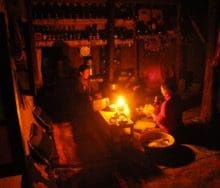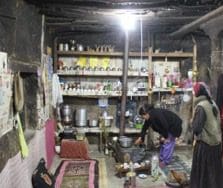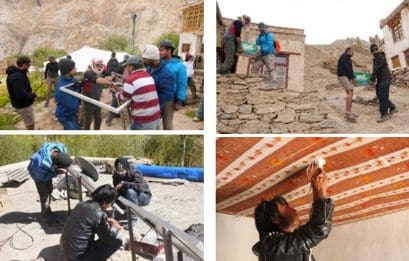The availability of electric power and its ability to drive economic productivity is a long-established characteristic of developed nations. Access to electricity, however, is far from universal. According to the International Energy Agency’s World Outlook 2016, 1.186 billion people around the world lack electricity and its benefits. About one-sixth of the world’s population, particularly in sub-Saharan Africa and developing countries in Asia, live without lights, communications, adequate education, healthcare and economic opportunity.
The potential to provide the benefits of electricity to those without it is vast. Electric power can light the night, run fans, charge mobile communication devices, power water pumps for irrigation, enable access to education and healthcare services, run stoves – all of which contribute to fundamental human well-being, self-sufficiency and dignity and drive economic development.
Funding and building electrical infrastructure in places that lack electricity, however, is an expensive, slow and unrealistic solution. Instead, small, independent systems based on low-voltage direct current (LVDC) power provide an opportunity to bring the benefits of electricity rapidly and relatively inexpensively to one-sixth of the world’s population. LVDC systems are by definition efficient and sustainable because they are based on solar photovoltaic panels that produce DC electricity and these systems power devices that consume DC electricity. This DC-to-DC arrangement skips the DC-to-AC conversions characterized by unnecessary power losses.
Imagine how access to electricity could change more than a billion lives. Electric lights extend the productivity of the day into the night, making families safer, cooking easier and enabling students to do their homework after sunset. The ability to charge a cell phone or mobile device enables communications that can support economic opportunity and improved education and healthcare. Powering water pumps for irrigation increases food production and lessens the occurrence of famine.


Villagers like these used to depend on kerosene lamps to cook and do home homework at night. With LVDC, they now are able to prepare food and study more safely and reliably, ultimately helping them thrive.
An Introduction to Low-voltage DC (LVDC) Technology
Low-voltage direct current or LVDC refers to the production and use of DC power at or below 1100 volts (V). Though DC traces its roots to the origins of commercial electricity, and was championed by Thomas Edison, alternating current (AC) championed by Nicolas Tesla and George Westinghouse won out for large-scale electricity distribution. However, LVDC has several attractive applications arising from the fact that renewable energy sources generate DC power, batteries use DC power and homes and commercial buildings depend on – or can readily be adapted to depend on – DC-based lighting, electronics and appliances.
Today LVDC is being harnessed to benefit humanity via two basic approaches. First, LVDC enables small-scale renewable energy projects that provide power in rural or remote villages in developing countries that lack basic electric infrastructure. Second, LVDC can benefit energy efficiency (EE) efforts in developed countries to minimize carbon emissions by serving microgrids with similar functions for homes, commercial buildings, even large-load data centers.
The application of LVDC in rural areas that lack power infrastructure is possible because both solar photovoltaic (PV) panels and wind turbines produce DC power. Supported by related IEEE standards, standalone systems – essentially, microgrids – can be built relatively swiftly and inexpensively. These systems are efficient because both the power produced and consumed is DC, whereas in developed countries, the DC power from solar PV is converted to AC, injected into the grid, then reconverted to DC to power most electronics and home appliances. Each conversion results in a loss of power and, therefore, reduced energy efficiency. Small, self-contained systems also leapfrog the need for constructing expensive infrastructure in areas without access to the grid.
LVDC systems can play a role in developed countries as well. Renewable energy sources that produce DC power can be used to power DC-based microgrids, where the load is also DC. This enables greater use of sustainable, non-polluting renewable energy sources and, therefore, lower carbon emissions than fossil fuel-based power generation. The use of LVDC systems may also provide load-shedding opportunities for grids and uninterrupted service for basic electricity needs when grid outages occur.
IEEE fosters LVDC through many efforts, initiatives and programs such as the work being done in the IEEE Standards Association, IEEE Smart Village and The Nepal Earthquake Rehabilitation Project:
IEEE Standards Association
IEEE Standards Association (IEEE SA) develops standards, supports programs and signs memos of understanding (MOUs) that address every aspect of design and build for projects such as DC-based microgrids in developing nations. Global standards grow markets, lead to economies of scale and lower costs to end users, encouraging technology adoption and innovation.
In 2014, IEEE SA through its Industry Connections program created an India LVDC Forum program in partnership with the India Ministry of Power Central Power Research Institute (CPRI) to test an all-DC microgrid, a DC-powered commercial building and a DC-powered home. In 2015, IEEE SA signed an MOU with the Bureau of Indian Standards (BIS), signifying BIS’ recognition of IEEE SA’s global standards by India’s standards authorities.
IEEE SA also supports LVDC by writing standards that enable the design, construction and implementation of LVDC systems, including IEEE P2030.10™ – Standard for DC Microgrids for Rural and Remote Electricity Access Applications, which addresses the means to bring electricity to underserved populations by enabling distributed generation and providing the requirements for LVDC and AC power to off-grid loads.
IEEE Smart Village
IEEE Smart Village is an IEEE Foundation Signature Program whose mission is to empower off-grid communities through education and the creation of sustainable, locally owned, energy-related businesses. LVDC-powered solar microgrids play a large role in these efforts by providing electricity that is safe and easy to operate and maintain by villagers. These microgrids power LED lights (replacing unhealthy kerosene lamps) and LED televisions, and fans, which allow remote villages to host eco-tourists for economic development.
At a GHE Himalayan Innovation Center in Lingshed, Ladakh, India, 24-volt computers and satellite access provide local children with educational resources that include curated, offline Internet content, Wikipedia, Khan Academy, TED talks and curricula pre-loaded on a 500 gigabit (GB) Wi-fi enabled server.
The IEEE Smart Village program has completed many projects, serving more than 50,000 people in 34 villages:
- In the Himalayas in India, many extremely remote villages have been electrified.
- In Sub-Saharan Africa, off-grid villages have been electrified in Nigeria, South Sudan, Zambia, Cameroon and Kenya.
- In the Caribbean country of Haiti, in partnership with the Sirona Cares Foundation, community charging stations have been deployed, enabling local entrepreneurs to lease portable battery kits for lighting and cell phone charging.
The direct benefits to affected villagers include sustainable, healthy lighting for safety, education, food preparation, electricity to charge mobile phones and power irrigation pumps and the means for entrepreneurs to make a profit providing electricity to their neighbors at less cost than polluting kerosene lamps and stoves.

This LVDC solar microgrid installation in a remote village in the Himalayas provides villagers with LED lights and fans, enabling a better quality of all-around living. In addition, electrification of this village has encouraged eco-tourism and thus, local economic development.
The Nepal Earthquake Rehabilitation Project
IEEE and many of its regional chapters launched The Nepal Project in the wake of two devastating earthquakes in April and May 2015. An ad hoc committee was formed to respond and it coordinated the distribution of scores of solar-powered lights and construction of solar-powered LVDC microgrids to help the most affected villages to recover, as well as small-scale water purification systems.
For more information on IEEE AND LVDC:

